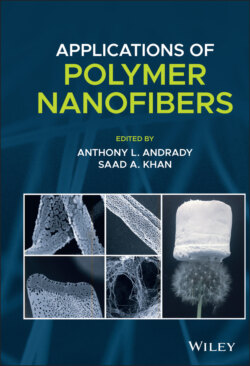Читать книгу Applications of Polymer Nanofibers - Группа авторов - Страница 16
1.2.2 Experimental Results
ОглавлениеCollectively, theoretical considerations indicate that fiber size is affected by applied electric field strength (applied voltage and time to collector distance), volumetric flow rate, and polymer solution (viscosity and conductivity). However, experimental results have been system‐dependent. For example, experiments increasing the voltage has been observed to decrease fiber diameter for many systems such as polyacrylonitrile/DMF and aqueous polyvinyl alcohol due to greater stretching and a stronger electric field. (Andrady 2008). For polyacrylonitrile in DMF, fiber diameter was reduced from ~95 to 50 nm by increasing the voltage from 5 to 25 kV. Conversely, fiber size has increased with increasing voltage. For example, the polystyrene (PS) fibers increased in diameter from 0.31 to 1.72 μm when the applied voltage increased from 5 to 25 kV. The discrepancy in experimental observations indicates that the effect of voltage on fiber size needs to be considered with other process parameters, especially the feed rate and tip‐to‐collector distance. Notably, at higher applied voltages, there is a greater tendency for bead formation. The bead density increased with increasing voltage and the shape of the beads transitioned from spindle‐like to spherical‐like indicating instability of the jet (Ramakrishna 2005).
Tip‐to‐collector distance influences the time of travel, amount of drying, and electric field strength (depending on the applied voltage) and thus the resulting fiber diameter and morphology. Practically, the distance must be large enough to prevent corona discharge. Generally, increasing the tip‐to‐collector distance with other parameters kept constant reduces fiber diameter. For example, electrospinning polystyrene in chloroform, the fiber diameter decreased from 1 to 0.66 μm by increasing the distance from 5 to 25 cm due to increased time of travel and stretching. Conversely, increasing the distance has also been observed to increase fiber diameter due to the reduced electric field strength. Decreasing the tip‐to‐collector distance and resulting time of travel and amount of drying can lead to deposition of “wet” fibers that fuse on the collector. While higher electric field strengths can be achieved at shorter distances, it can often result in the formation of beads or an unstable Taylor cone if the distance is not sufficient for development of the whipping instability (Andrady 2008; Ramakrishna 2005).
Continuous nanofibers of uniform diameter are achieved when the feed rate matches the rate of at which solution is removed from the tip. At lower feed rates, fibers may form intermittently. Higher feed rates increase the tendency to form beads. Given sufficient applied voltage, the average fiber diameter increases with feed rate. Increasing the feed rate can also result in fused fibers. With larger volume of solution drawn from the needle top, the solvent may not completely evaporate. The residual solvent may cause the fibers to fuse together when deposited (Andrady 2008; Ramakrishna 2005).
Overall, the experimental results generally agree with the scaling analysis, i.e. the final fiber diameter is directly proportional to volumetric flow rate as well as polymer concentration/viscosity. The electric field strength, dictated by the applied voltage and tip to collector distance, also affects fiber diameter. However, various effects have been observed (e.g. increasing the applied voltage may increase, decrease, or have no effect on the fiber diameter depending on the system) due to the complexity of the process. Some authors have performed systematic experiments varying process parameters and used regression analysis (Cui et al. 2007) or neural network models (Sarkar et al. 2009) to establish quantitative relationships. However, these analyses are system‐dependent. There are no methods to date to predict the fiber size based on solution properties and process parameters (Helgeson et al. 2008; Thompson et al. 2007).
